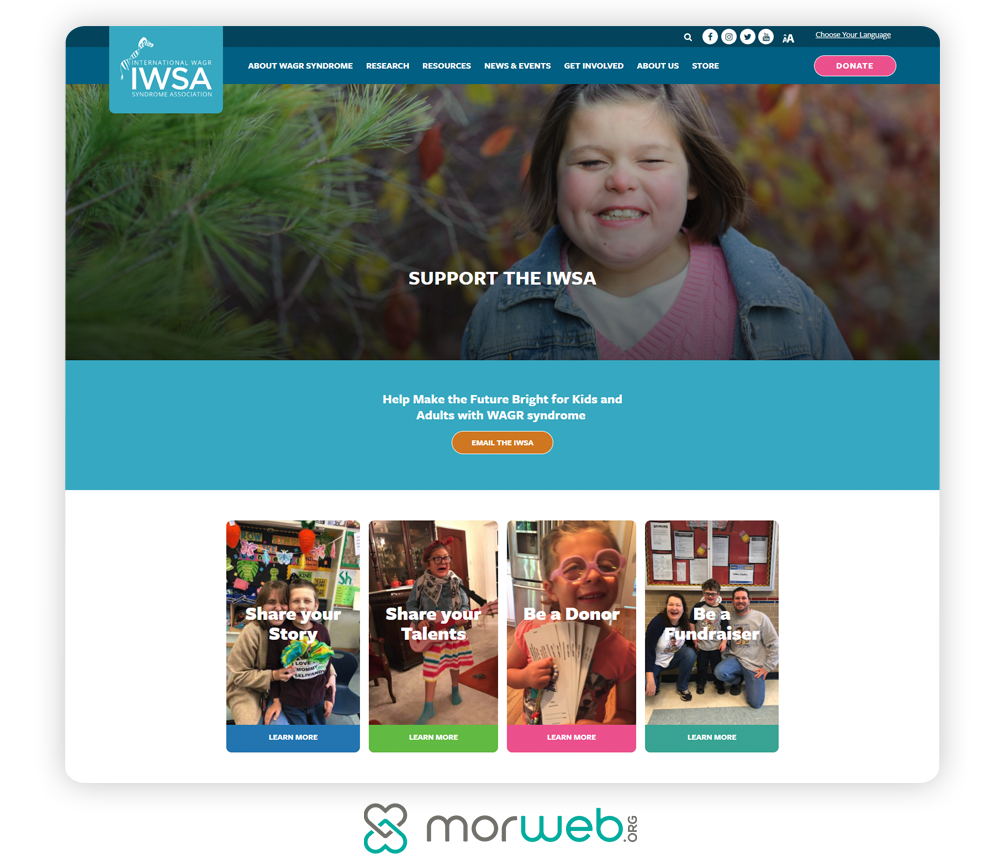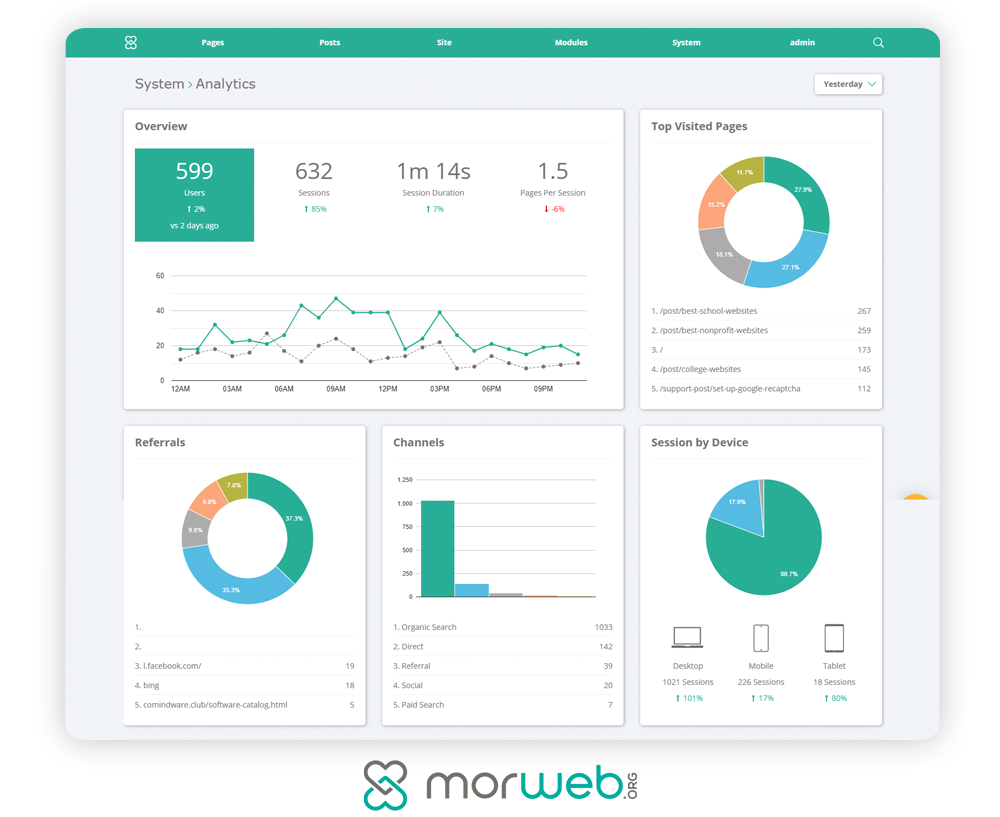Today’s article dives into the digital landscape of nonprofit websites. As websites are often a potential donor’s first impression of a nonprofit, it’s important to optimize for user experience, engagement and security. Murad Bushnaq shares the expertise he’s gained as the Founder and CEO of Morweb, a CMS platform dedicated to helping nonprofits manage and grow their websites.
Modern nonprofits are becoming increasingly tech-literate. This means that nonprofit websites are better designed, have increased usability, and engage donors more effectively than ever before. The digital space is highly competitive and nonprofit organizations need to do more to stand out online.
Modern nonprofits have to make a deliberate effort to keep up with new forms of online giving and find the most intuitive website features to support a stronger digital presence. If your nonprofit has a smaller fundraising team, constantly researching and adding new upgrades can quickly become a full-time job. While there are many useful web design features out there, there are also a lot of useless and scam solutions, and sorting through them takes time that you could devote to other fundraising activities.
To help your nonprofit find the features that will take your website to the next level, Morweb’s team of nonprofit and association website design experts have put together this article explaining four key features you can add to your website, including:
- Blog and Social Media Integration
- Up-to-Date Security Measures
- Matching Gift Features
- Web Analytics Tools
Each of these features improves a specific part of your website or can provide vital insight into how you can improve your site as a whole. To implement these web design elements easily, make sure you’re first backed by a robust website builder that offers the right tools and provides access to a team of web design experts to provide additional support when needed. As a result, you’ll be able to stay on par with your tech-savvy competitors and stand out online.
1. Blog and Social Media Integration
Your website is the centerpiece of your online fundraising strategy, but that doesn’t mean it’s the only component. Think about your presence in other virtual spaces, such as social media, and how you can leverage the valuable content on your website on those platforms.

This ties into optimizing your website for search engines such as Google. It doesn’t matter how well-designed your website is if no one ever sees it. Fortunately, you can improve your chances of appearing in qualified prospects’ search results by continually updating your website to maintain a healthy level of activity.
You can stay active without overwhelming your content creation team by:
- Adding a blog. Most nonprofit blogs contain articles explaining key concepts and developments in their field as well as their personal work to promote their cause. Doing so provides valuable information and builds authority with supporters. These articles can also be shared across social media, driving further traffic to your website (and potentially leading to more donations).
- Integrating social media pages. Maintaining a news page alongside multiple social media profiles can be a tall order for your marketing team. In addition to posting articles on your social media profiles, you can embed your Twitter or Facebook feed into your website.
Maintaining a blog and active social media presence is also a best practice for membership websites and programs. If you have a membership or subscription program, your members will expect regular new content to make their monthly contributions worth it. Posting new articles, videos, and other content shows members what they’re supporting and gives them a reason to continually check your website, increasing traffic.
2. Up-to-Date Security Measures
Security is often something that’s only considered once a serious issue occurs. Protecting your supporters’ data should be one of your highest priorities when designing your website, so you’ll need to pay extra attention to your security practices when adding new features from third-party creators.
As you add features to your website, you can enforce stringent security measures by:
- Researching new features’ credibility. When you add a plugin or other third-party feature to your website, thoroughly research it to ensure that it has an active programmer creating updates, contains features that will improve your website, and—above all—is legitimate.
- Installing updates. When using an open-source CMS, it’s tempting to put off installing the next security update for your web builder and other integrated software features. However, many updates are created specifically to counter vulnerabilities, and leaving your website outdated can put your data at risk. As a quick solution, select a CMS that takes care of the security and maintenance for you.
- Purchasing software solutions with strong security protocols. Integratable features such as your payment processor come with their own security measures. Thoroughly research what protections are in place, and ask potential software providers any security questions you might have before investing in their software.
Knowing what to look for regarding security measures requires some technical knowledge. If you’re unsure how to assess the safety of new website features and software, reach out to a nonprofit website development consultant for advice. They have years of experience dealing with similar problems, and it’s always best to be safe rather than sorry when it comes to protecting your supporters’ data.
3. Matching Gift Features
Your donation page is one of your website’s key features, and chances are it can be further optimized to make the most out of every donation received. Many corporations have philanthropic programs that your nonprofit can tap into, earning more dollars for every donation made through matching gifts.

Matching gifts are donations that businesses make when their employees give to a nonprofit, often at a dollar-for-dollar rate. You can improve your website’s donation page by adding a matching gifts search tool feature, allowing donors to check their matching gift eligibility and request a donation from their employer.
Unfortunately, it’s not enough to simply add a matching gift tool to your donation page and leave it at that. According to 360MatchPro’s guide to matching gift databases, an estimated $4-$7 billion in matching gift funds goes unclaimed every year, usually because many donors don’t know what matching gifts are, let alone if they are eligible.
You can help educate your donors by featuring informational content about matching gifts on your donation page or other informational pages about giving to your organization. For example, if you have a page dedicated to explaining the impact of donating, you can add a section to teach visitors about corporate matching gift programs and encourage them to look into their employers’ CSR initiatives.
If you’re ever unsure about using a matching gift platform, online resources like this one can be helpful for answering common questions and providing insight into what you should look for in a matching gifts tool. Different corporations have different rules for their matching gift programs, so don’t panic if you find yourself confused about how to proceed with a specific employer.
4. Web Analytics Tools
How do you know if you’ve positioned your website to maximize your fundraising? If you’re not monitoring how users interact with your website, you’ll never know what’s working and what needs improvement.

Web analytics tools are backend tracking and data collection tools that monitor, measure, and report how your visitors are using your website. Additionally, these tools can tell you how users are finding your website, allowing you to make smarter, data-driven decisions for your online marketing campaigns.
While different web analytics tools provide different information, you can expect your provider to create reports on:
- Traffic over a set period of time. How many people visit your website? You can additionally check how many are first time or repeat visitors.
- Click-through rates. You likely send out many links to your website through your marketing emails. Monitoring your click-through rate will let you know what percentage of those links are clicked on.
- Bounce rate. Users “bounce” when they view only a single page on your website before exiting out. You can improve pages with a high bounce rate by adding other useful links, encouraging visitors to continue exploring your website.
- Session duration. How long are visitors on your website? Sometimes users will only view one page but keep it open for a long period of time, which means that page likely still has value even if the user doesn’t navigate to any other pages.
- Conversion rate. How many visitors complete the task you want them to perform on your website? For nonprofits, this is usually donating, but it can be filling out a volunteer form, subscribing, sharing an article, purchasing merchandise, or anything else. Set a goal in your analytics tool and monitor where users drop off in their conversion, so you can make targeted improvements to the process.
- Landing pages. What pages do users navigate to when they first reach your website? Monitoring landing pages can let you know if you have content such that’s being widely shared.
Even the best nonprofit websites can benefit from monitoring user activity and targeting pages that their analytics tool indicates need improvement. You can test your website yourself by navigating through it as if you were a visitor, but that still will only be one perspective. Understanding the bigger picture of how hundreds or thousands of people view your website allows you to make changes based on how supporters interact with your content.
The Gist
Maintaining an effective nonprofit website is an ongoing responsibility, and you’ll need to regularly research and add new features to keep your website up-to-date. Fortunately, there are tools you can implement to help measure your website’s effectiveness, maintain security, and make the most of each donor interaction while you search how to make your next visitor’s experience better than the last’s.

